Dear Reader, in this age of AI created content, please support with your goodwill someone who works harder to provide the human-made. Sign up at the top of the lefthand column or bottom of this page. You will receive my hand illustrated monthly newsletter RESTORE NATURE and access to the biodiversity garden design course as I write...and nothing else, I respect your time. I am also removing the advertizing as best I can as its become intrusive inappropriate and pays me nothing.
16 ideas for a multipurpose ecological garden fence and garden wall
Greening up an existing
garden fence or wall
1) Trellis vines. An existing garden fence provides a trellis on which plants can grow. A trellis mounted on a wall can be made of renewable wood like bamboo.
Some trellises can be so beautiful that green growth on them is just an added bonus. In South Africa a group called Working for Water was felling alien trees which diminished our water supply. Black wattle and Port Jackson sticks were made into many great garden items including furniture and trellises. This would be a double service to the environment and surrounding yourself with calming green. You can also use second hand iron from metal dealers. I used reinforcing rods and wire to create a trellis over an ugly vibra-crete (concrete panel) wall, and grow beans. The foliage was attractive, the trellis a mere support. Wall space in a small urban garden represents a huge surface area you can use f
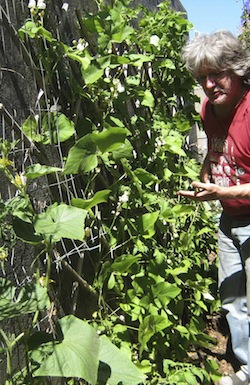 cucurbits, beans and tomatoes growing on a piece of old garden fence hung on nails in a narrow unused alley
cucurbits, beans and tomatoes growing on a piece of old garden fence hung on nails in a narrow unused alleyor growing, and it is usually forgotten, or attempts are made to camouflage the wall that do not make full use of its potential. Cucurbits, tomatoes, granadillas, grapes, Kiwi fruit and other fruit bearing vines, or even hops can be planted and trained over such a trellis. They can be perennial or annual.
2) Trellis fruit trees. Fruit trees can be trained to cover a wall and their branch patterns are part of the appeal of this form of horticulture. See links to pictures of how to train fruit trees at the bottom of the page under 'pictures of eco fences'.
3) Shelves. You can place shelves for your nursery or pot plants, especially if sunlight is at a premium in your garden, and the wall is one of the few sunny spots. They can be attached to the wall or hanging from chains or rope.
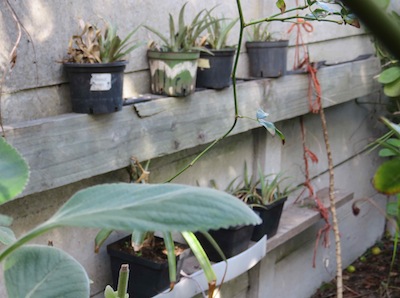 A shelf hung on recycled ropes used for pineapple cuttings
A shelf hung on recycled ropes used for pineapple cuttings4) Pots. You can bracket pots to the wall permanently, or hang baskets against it, or holders that can allow pots to be changed, or place a frame in front of the wall to attach many pots for a vertical garden, or you can hang vertical garden pockets, like a shoe hanger, a fabric structure with multiple pockets in which plants can be grown.
5) Double wall. You can build another wall in front of the existing wall, half up, that creates a planter box.
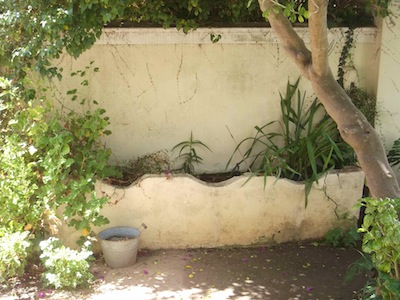 a sinuous wall planter at Irma Stern museum.
a sinuous wall planter at Irma Stern museum.6) Greenhouse
Put up a lean-to greenhouse against the wall for growing in winter and warming your home with solar energy. It need only be a meter wide. See green houses on walls and fences in the link at bottom of page.
Eco ideas for building
a garden fence or wall from scratch
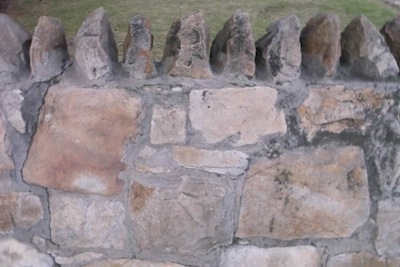 Local stone, Kalk Bay
Local stone, Kalk Bay1) Stone dry wall
If you have stones in your garden, you can use them to build a wall that is part of your terracing, or a freestanding wall, with the gaps filled with concrete. The disadvantage is that a closed wall can dam up groundwater if it is a terrace wall, which exerts enormous pressure, and if it is over a certain height you need an engineer to design it. You can also build a dry wall that has no mortar in it as a terrace wall. I built a low dry wall in my garden. I stuffed the gaps with plastic bags, straw and clay, otherwise the water would just pour through. If you live in a wet climate this is not a bad thing. A dry stone wall creates a nice well drained microclimate above the wall and a more cool, most area at the base of the wall, where plants have a cool root run and profit from runoff when plants on the terrace are watered, and from the water condensing property of the stones.
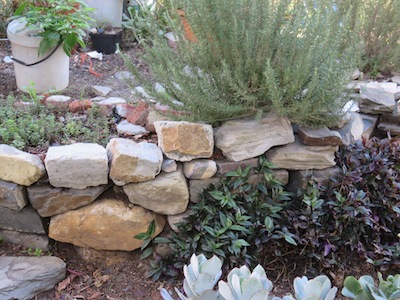 my dry wall terrace, herbs above and waterlovers below
my dry wall terrace, herbs above and waterlovers below2) Mud brick
there are beautiful traditional mud brick walls in our region. The wall is capped with a sloping roof and plastered to ward off the rain. Rocks and mud brick were both used to build the interior of the walls. If your climate is suitable and you have clay and local skills available it is a great choice as it has a zero carbon footprint compared to bricks, concrete, cut wood, metal and plastic.
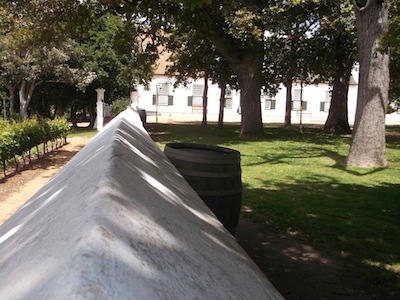 Old mud and stone wall capped with plaster for rain
Old mud and stone wall capped with plaster for rain3) Second hand
there are many second hand building materials available. My stone was on its way to the dump when I hijacked it and brought it home. Demolition companies have second hand bricks and other materials. Scrap metal dealers have a range of unused and used materials. This is where I bought the materials for the bean trellis on my back wall.
4) Recycled materials
There is a huge range of recycled material you can use to build walls and garden fences, from old bleached wood to used plastic bottles, broken bricks or cement shatter from your local city waste depot. I’ve seen a garden fence made out of metal sheeting that was a byproduct of an industrial process in which it was punched with large round holes. As my garden space is limited, I will refer you to collected pictures for the rest of the suggestions. See the bottom of the page.
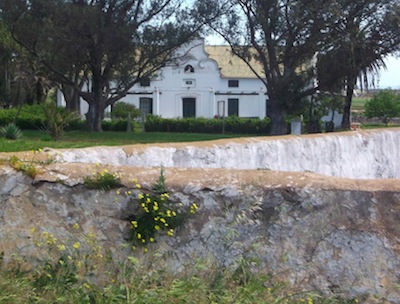 On the dry west coast an uncapped wall lasts well
On the dry west coast an uncapped wall lasts well5) Hedge
You can build a green wall with plants. You can use the usual hedge plants like box or yew, depending on your area, but you can make the hedge multipurpose by planting flowering or fruiting trees trained into a hedge, as well as berries, herbs, or spice plants like laurel. You can also put up a wire garden fence or wooden fence that can serve as a trellis for fruiting vines like grenadilla, grape, kiwi, brambles blackberries and so forth.
6) Renewables
You can build a garden fence with renewable organic materials, even alien woods that need to be removed from your area. There are beautiful woven fences which can be made from thin wands and sticks. Living willow or bamboo is also used.
7) Stacked
You can stack your chopped wood, or logs, laying them flat on a woodpile that eventually forms a wall. The bonus of this idea is that it helps you dry excess wood, and you can add fresh wood at the one end and harvest from the other, it is gorgeous and acts as a giant insect and spider hotel. You don’t need to buy one and hang it up in your garden.
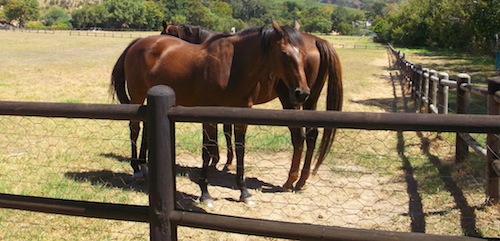 a garden fence built from renewables can be anything from sturdy split poles, to woven or living willow wands (pinterest link below)
a garden fence built from renewables can be anything from sturdy split poles, to woven or living willow wands (pinterest link below)8) Gabions
Gabions are wire cages in which rocks are piled to make a solid stable block or wall. If the rocks in your garden are too small to build drywalls, you can use gabions. They may require some skill and special equipment. I have seen these walls everywhere but never made one. Gabbions could also be made using rubble like broken bricks and cement shatter. You could even fill them with industrial waste, or plastic bottles. With careful material choices this very green solution may look lovely or interesting.They could also be filled with organic matter, chopped down logs, sticks, leaves or straw.
9) Compostwall
An extension of the idea of organic gabions. The containing wall could consist of a wire framework, or renewable woven garden fencing, or even palettes, or plastic or wooden crates. The double walls will need to be anchored to each other in order not to fall outwards when very full. Into the hollows you empty finely chopped garden waste and kitchen waste. Start at one end and then move slowly along as the wall fills. You can plant veggies in the mature compost, either on the top or sides of the wall, and set up a cyclical process for getting rid of all your organic waste. If there is enough dry brown material the kitchen waste will not make a smell or attract flies.
 ivy grows up a concrete garden fence without support
ivy grows up a concrete garden fence without support10)
vertical garden
You can build a strong frame which supports a vertical garden on both sides for balance. As I’ve said above it can be made of buckets or pots hung on the wall, or pockets in a non rottable fabric, the construction possibilities are endless. At Kirstenbosch Botanical Garden there was one made of recycled plastic bottles used as planters, placed at 45 degrees.
I have used clear bottles hung vertically with a window cut out of them for planting into, but the best for looks is I think, hanging them sawn in half and hung neck down. The clear bottles soon go green with algae and give an overgrown hothouse feeling when the plants are trailing down a wall. Even an outdoor bookshelf with many pot plants on it will act as a visual screen.
------
home page for links to useful ideas on natural gardening
------
what is natural garden design and its benefits
------
You’re a home gardener ! Share your experiences and questions !
We all know about home gardening. Tell us about your successes, challenges and ask about issues that bother you. You may have the luxury of a back garden, but there are other ways we learn. Few people age without growing something or buying vegetables during their lives ! It is absolutely guaranteed that you have learned things which can help others on their gardening journey.
We invite you to share your stories, ask questions, because if a thing has bothered you it will bother others too. Someone may have a solution ! No question is too small. There is learning for everyone involved, for you, for me (yes, I learn from every question), for us all. Exciting stuff !
We are starting on a new journey. Every week we will profile your letters ! The best stories and questions we receive.
Restore Nature Newsletter
I've been writing for four years now and I would love to hear from you
Please let me know if you have any questions, comments or stories to share on gardening, permaculture, regenerative agriculture, food forests, natural gardening, do nothing gardening, observations about pests and diseases, foraging, dealing with and using weeds constructively, composting and going offgrid.
SEARCH
Order the Kindle E-book for the SPECIAL PRICE of only
Prices valid till 30.09.2023
Recent Articles
-
garden for life is a blog about saving the earth one garden at a time
Apr 18, 25 01:18 PM
The garden for life blog has short articles on gardening for biodiversity with native plants and regenerating soil for climate amelioration and nutritious food -
Cape Flats Sand Fynbos, Cape Town's most endangered native vegetation!
Apr 18, 25 10:36 AM
Cape Flats Sand Fynbos, a vegetation type found in the super diverse Cape Fynbos region is threatened by Cape Town's urban development and invasive alien plants -
Geography Research Task
Jan 31, 25 11:37 PM
To whom it may concern My name is Tanyaradzwa Madziwa and I am a matric student at Springfield Convent School. As part of our geography syllabus for this
"How to start a profitable worm business on a shoestring budget
Order a printed copy from "Amazon" at the SPECIAL PRICE of only
or a digital version from the "Kindle" store at the SPECIAL PRICE of only
Prices valid till 30.09.2023







